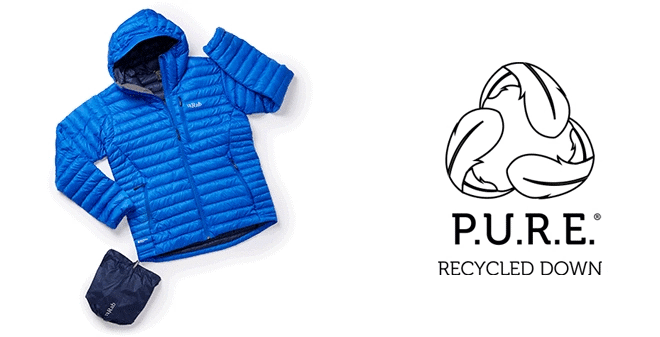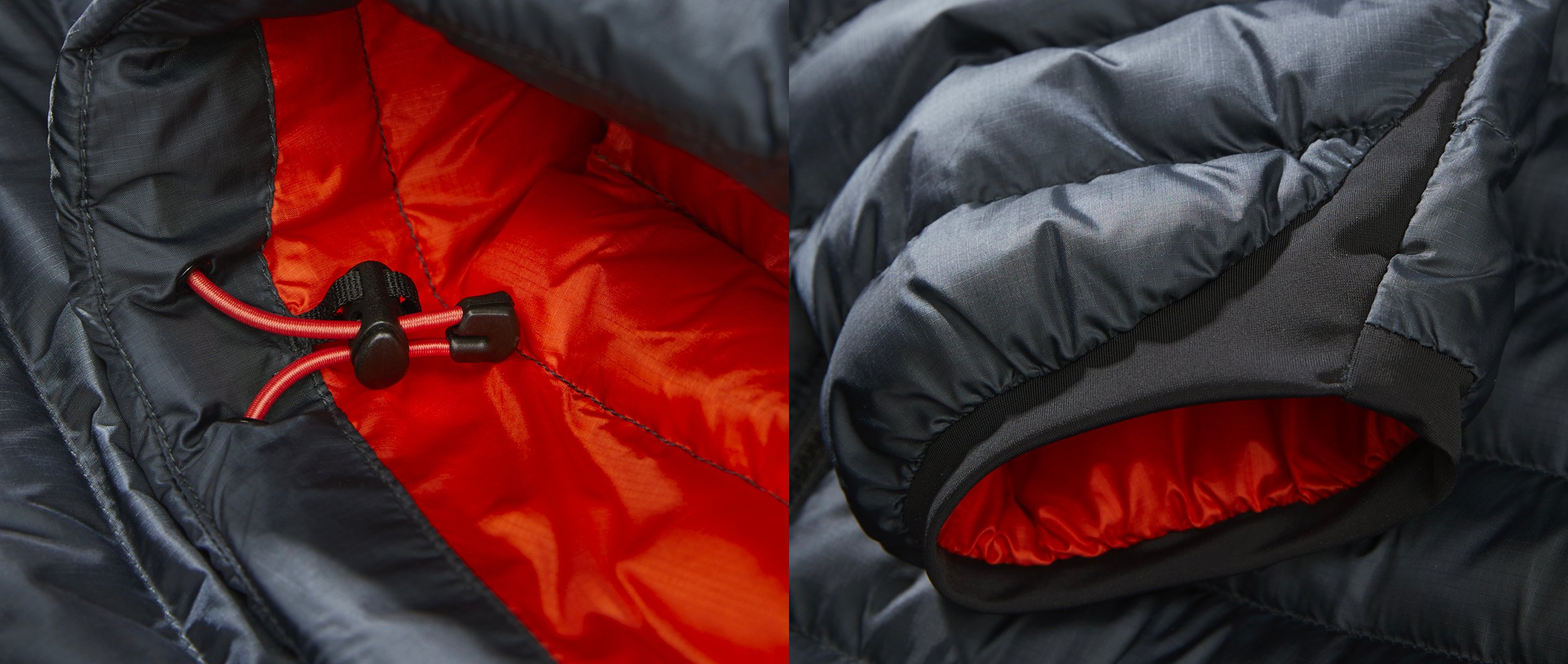Down Vs Synthetic | The Ultimate Guide to Insulation
Feeling unsure about whether you need down or synthetic insulation? Whether you’re going camping and considering an insulated down sleeping bag versus a synthetic sleeping bag; or need help comparing a down jacket against a synthetically insulated jacket, in this comprehensive guide we’ll look at both types of insulation and determine what’s right for you.
Until now, down has been considered the most effective insulation, but synthetics have improved tenfold in recent years and is often a fraction of the price. Hybrid insulation is also becoming a more popular choice, which combines down and synthetic to create a jacket or sleeping bag that is tailored to your specific needs. The truth is, all insulations have their place. Depending on your chosen activity and environment, you may want to consider a different style of insulation. Down is light and compressible, yet not so good in the wet, whilst synthetic insulation is abrasion resistant and warm even when wet but is heavier and less compressible.

What is Down Insulation?
Down is made from the soft, fluffy duck or goose plumage, which is found under the hardier, water repellent feathers and acts as a natural insulation. The high-loft down traps air in small pockets to create a highly effective thermal barrier.
What are the Benefits of Down Insulation?
Down is a natural, breathable, high quality option which will last you a lifetime, if cared for properly. It has an impressive warmth-to-weight ratio, keeping you super-toasty without weighing you down. Lightweight and highly compressible, down has natural moisture-wicking properties for all day comfort.
Down insulation is far more eco-friendly than synthetic rivals as it is a by-product of the meat industry, so if sustainability is a major factor for you, then a down jacket is the ultimate choice. Most brands use RDS certified down or recycled down, which ensures animals are well treated and not subjected to live plucking, so you can rest assured it's cruelty-free too.
When and Where Do I Need a Down Jacket or Sleeping Bag?
Down has to be the first choice for really cold, dry climates. Ideal for a variety of sports including mountain climbing, skiing, snowboarding, trekking, hiking and camping in winter months. If you’re on a multi-day trek or hike and short on space, down insulated products are an excellent choice due to their compressibility and lightness; you can store your jacket or sleeping bag in a backpack with ease. Down Insulated Jackets and Down Insulated Sleeping Bags can offer you high levels of warmth whilst remaining breathable and light. To protect your down sleeping bag and prolong its life, use a sleeping bag liner.
If skiing or snowboarding is your game, then opt for a two in one where the down insulation is protected by a waterproof shell outer. Many modern men’s down and women’s down ski/snowboard jackets offer all the benefits of down insulation with a fully waterproof shell to boot. A lot of down insulations are now treated to be water resistant/hydrophobic too, making it highly effective in all weathers. If you’re looking for something to wear on a daily basis, choose a jacket from the Rab Microlight Alpine Range.
The Disadvantages of Down Insulation
The ‘down-side’ to down is that it doesn’t retain its insulating power when wet, although as we previously mentioned, many down insulations are now being treated to be water resistant and many jackets come with a waterproof shell. You could also use your down jacket as a mid layer underneath a waterproof shell. See our Absolute Guide to Layering to learn the art of layering. Down Insulation also requires a bit more tender loving care than a synthetic jacket, with minimal machine washing advised. Another major factor here is price - down can be expensive, especially when opting for a high fill power. However, if you have the funds available, it’s a worthy investment.
Types of Down
Mature/High-Loft Goose Down has the finest construction making it the lightest and warmest down available and is therefore usually the most expensive.
Standard Goose Down has a slightly lower fill power/loft but is still highly effective and more affordable.
Duck Down is not as commonly used as it is not as soft with a considerably lower fill power which is reflected in the price.
What is Fill Power?
Don’t be afraid, it’s really very simple. Fill power is essentially a way of measuring the quality or effectiveness of the down, with 450 usually the lowest and 900 the highest. The fill power refers to the number of cubic inches in which an ounce of that particular down can be stuffed. A finer, better quality down will compress more easily and puff back up again to create more loft. To determine the warmth of a down insulated jacket you will need to look at the fill power and also the weight - a 900 fill power jacket with 50g of down will be equal in warmth to a 450 fill power jacket with 100g of down but will be lighter and more compressible, hence it being more expensive. It’s much easier to gauge the warmth of a sleeping bag as they are given a specific range of comfortable temperatures, but it is still worth considering how light and compressible you need it to be when making your purchase.
You might also come across grades which refer to the ratio of down to feathers which is shown by percentage.

What is Synthetic Insulation?
There are endless types of synthetic insulations with many brands creating their own unique patents. Synthetic insulation is generally made from man made polyfibres with pockets of air to mimic down, some being considerably more successful than others. The technology in the synthetic insulation industry has improved endlessly in recent years and will no doubt continue to improve.
What are the Benefits of Synthetic Insulation?
Synthetic insulation’s main hold over down is its ability to keep its insulating properties even when wet. It dries much faster too and is often highly breathable with moisture-wicking properties as well as being less bulky. Synthetics are generally more abrasion resistant than down alternatives and can be washed more easily and regularly. Another advantage of synthetic insulation is, of course, the price, usually being considerably cheaper than down. Synthetic insulation is the obvious choice for anyone wanting a cruelty-free/vegan or hypoallergenic option.
When and Where Do I Need a Insulated Jacket or Sleeping Bag?
Synthetic insulation is a fantastic choice if you are in a wet or humid environment or if you are exerting a lot of energy and working up a sweat. With this in mind, plus the fact that synthetics are tougher and more abrasion resistant, they are particularly suited to rock climbing and the like. A synthetic insulated jacket will serve you well on the rock face. Synthetics are also ideal for activities such as cycling, running, rowing, hiking or walking in a variety of weather conditions. If you’re an active person and looking for something versatile that you can wear all year round, the Montane Icarus range comes highly recommended. If you’re going travelling, a Synthetic Sleeping Bag could come in handy as they’re washable and budget-friendly.
The Disadvantages of Synthetic Insulation
Synthetic insulation breaks down a lot quicker than its natural down rival, so your jacket or sleeping bag will have to be replaced sooner and is a less sustainable choice. It might be cheaper in the short term, but you might end up paying more in the long run. Synthetic insulation is also heavier than down, so has a less impressive warmth-to-weight ratio and is not as compressible, although with technologies improving all the time, some synthetic insulations are giving down a run for its money so it's worth doing your research. It loses heat more quickly, although this could be seen as an advantage if you are taking part in a high intensity sport such as cycling or running.
Types of Synthetic Insulation
PrimaLoft - Considered the holy grail of synthetics, PrimaLoft is made from ultra-soft microfibres comparable to down whilst remaining lightweight and water repellent. Not only is it durable but it has one of the best warmth-to-weight ratios in the synthetic insulation market.
Thinsulate - The ultra-fine microfibers used in Thinsulate act like natural down, trapping heat more effectively than other generic synthetic insulation and it will keep you warm even when wet. There are 4 weights to choose from, 40, 80, 100 and 150 grams.
Plumafill - Created by leading brand Patagonia, this revolutionary insulation is one of the best out there. Made from a continuous synthetic insulation that mimics the structure of natural down, Plumafill is warm when wet and is highly compressible and lightweight in comparison to other synthetic insulations.
Hybrid Insulation - The Best of Both Worlds
Still unsure whether down or synthetic is your calling? Maybe opt for a hybrid insulation. Hybrids contain both natural down and synthetic fibres in an effort to reap the benefits of both. In hybrid jackets, the two insulations are often used zonally, with down in larger areas such as the back and chest for warmth and synthetic insulation in areas that aid freedom of movement such as the sleeves and hood. Another technique, often used in hybrid sleeping bags, is to combine the two insulations throughout, a well balanced mixture of natural down and hollow-fibre insulation can offer superior warmth, moisture control and more. Hybrids can be suitable for a very wide range of sports and climates due to their versatile and all-encompassing nature.

The Final Say...
Whether you’re off to cycle The Friendship Way, scale Mount Everest, or explore the beautiful countryside right on your doorstep, we hope this guide has helped you to understand the different benefits and disadvantages of down, synthetic and hybrid insulations. Whatever your activity, environment or budget, there’s something out there for everyone. See the table below for a quick summary of this article.
*It is worth noting that although down is not waterproof, many modern down jackets have a fully waterproof, impenetrable outer layer making this disadvantage null and void.
**Whilst many synthetic insulation types are still heavier than down, some modern synthetics can now seriously compete when it comes to weight. Lighter synthetics are becoming more widely available.
The comments in the above table are generalised and are not true to all products. It is always worth reading the finer details about the product you are interested in buying.
If you’re still feeling indecisive, here’s a lowdown on Absolute Snow’s favourite insulated products.
| Down Insulation | Synthetic Insulation | |
|---|---|---|
| Best Environment | Cold/Dry Climates | Wet/Humid Climates |
| Best Sports/Activities | Skiing, snowboarding, winter trekking, hiking and camping, general everyday use. | Rock climbing, cycling, running, hiking, camping, general everyday use. |
| Price | £160+ | £90+ |
| Major Benefits | Best Warmth-to-Weight Ratio, Highly Compressible, Longevity/Quality, Sustainable/Eco-Friendly | Warm Even When Wet, Quick Drying, Washable, Abrasion Resistant |
| Disadvantages | Loses Insulating Properties When Wet*, Harder to Care for (How do I care for a down insulated jacket?), Expensive | Heavier than Down**, Shorter Lifespan, Less Sustainable/Eco-Friendly |
Check out our full range of Sleeping Bags or Down Jackets today!
Need further advice? We're here to help!
Check out our Buying Guides for technical tips and tricks.
Visit our Help Centre to speak to our experts.